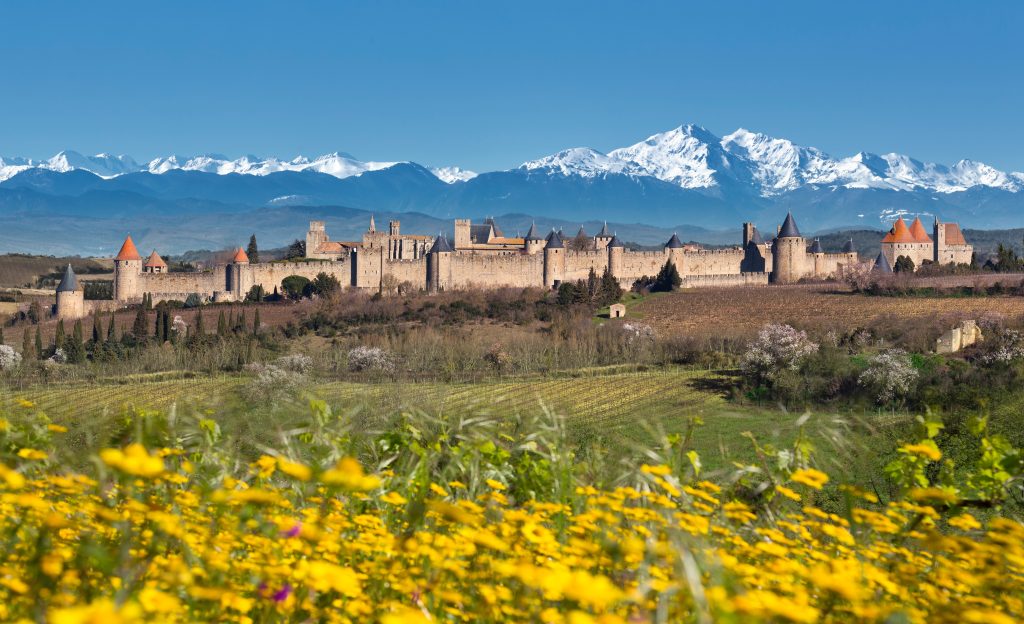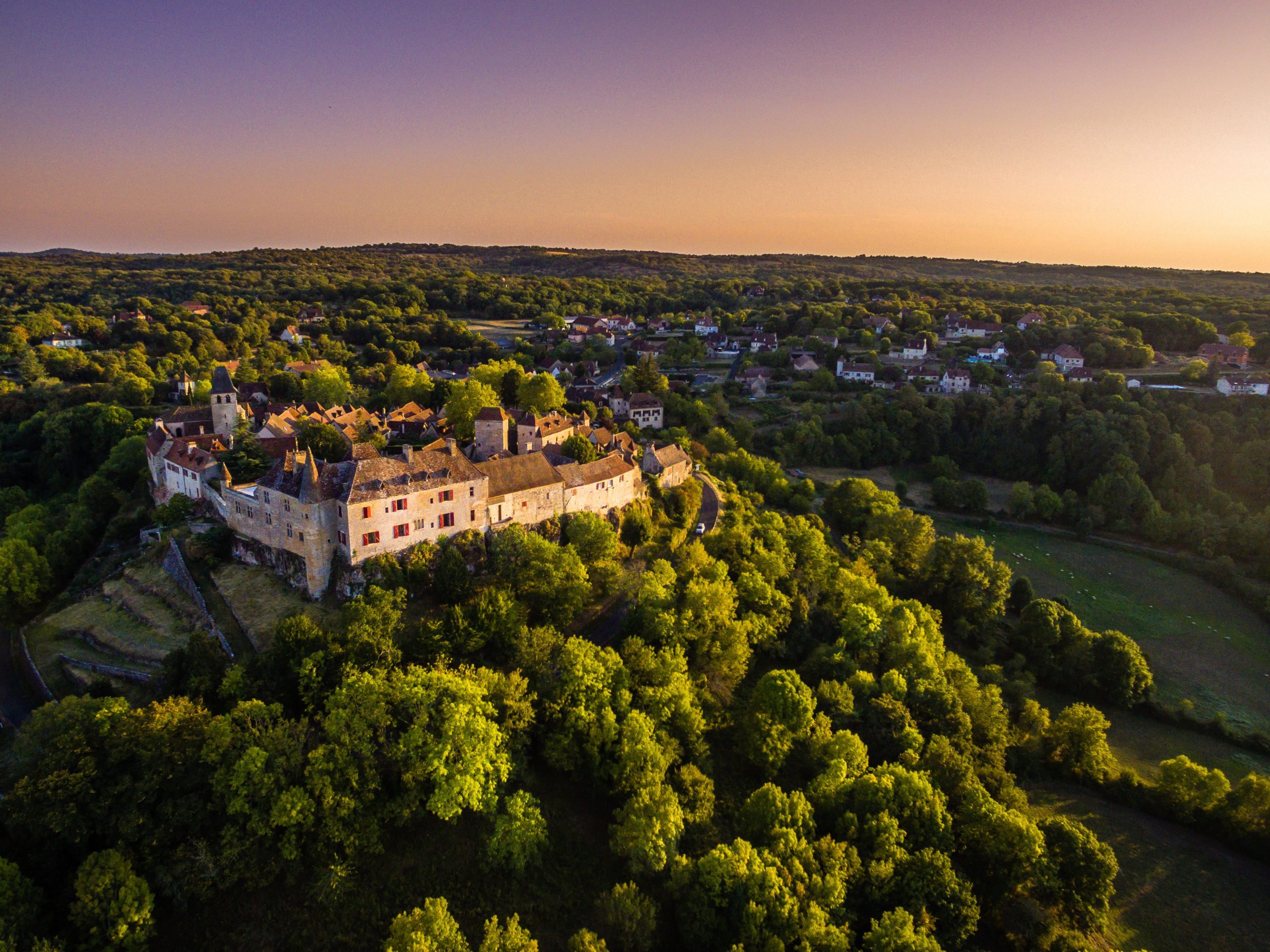On the slopes of the snowcapped Pyrenees, the Occitanie region in southwestern France features a plethora of character-filled villages and outstanding medieval architecture. The Occitanie area, formed in 2016 by the merger of two smaller but well-known regions, Languedoc-Roussillon and Midi-Pyrenees, offers even the most adventurous travelers.

Whether you want to visit enchanting Disney castles, taste the finest French wines and cuisine, learn about the quaint culture of traditional fishing communities in France, or walk the Pyrenees’ wildest stretches, Occitanie has it all.
Occitanie is an excellent choice for history and architecture-loving couples. The UNESCO World Heritage Sites in the region include the Pont du Gard, the Cirque de Gavarnie, the cities of Albi and Carcassonne, and the Camino de Santiago de Compostela pathways.
Whether you want to visit enchanting Disney castles, taste the finest French wines and cuisine, learn about the quaint culture of traditional fishing communities in France, or walk the Pyrenees’ wildest stretches, Occitanie has it all.
Occitanie is an excellent choice for history and architecture-loving couples. The UNESCO World Heritage Sites in the region include the Pont du Gard, the Cirque de Gavarnie, the cities of Albi and Carcassonne, and the Camino de Santiago de Compostela pathways.
The Pont du Gard (A Feat of Roman Architecture)
The Pont du Gard is France’s most visited ancient landmark and a symbol of Roman engineering genius. This first-century structure, about a half-hour drive from Nimes, is notable for its size and distinctive architectural style. It’s a tremendous treat to walk around it on foot, especially since it’s the world’s highest Roman bridge-aqueduct. A museum, exhibition halls, and a cinema screening a documentary with amazing images are among the attractions on the site. In 1985, UNESCO designated it a World Heritage Site.
With trails extending up both sides of the river and overlooks from below, the wonder of the Pont du Gard may be admired from a variety of perspectives. A pathway on the top of the three-tiered building can be accessed with a guided tour. A modern museum provides information about the aqueduct’s history and operation, while a short film combines documentary and fiction. A riverbank beach is a beautiful place to swim in the summer, with the old marvel as a backdrop.
The Cirque de Gavarnie (Living History in the Pyrenees)
The Cirque de Gavarnie, the only French monument listed as a World Heritage Site for natural and cultural criteria, is a must-see for adventurous couples in Occitanie. It is part of the ‘Pyrenees – Mont Perdu (Forgotten Mountain)’ territory and is a geologically significant place with its 423-meter waterfall, one of Europe’s highest. Walking to the cirque along the Gavarnie stream is an incredible experience that shows how the mountain range that separates France and Spain was built. Since 1997, it has been a UNESCO World Heritage Site.
The Cirque de Gavarnie, located in the Parc National des Pyrenees, is a UNESCO World Heritage Site. This means that tight rules are in place to protect the area’s natural resources and wildlife. Even on a leash, dogs are not permitted. Picking wildflowers is prohibited; lighting a fire and camping are not allowed. No aerial or shooting activities are permitted, and riding a mountain bike or driving a vehicle is not permitted. In general, respect the national park and its surroundings with care.

The Cirque de Gavarnie (Living History in the Pyrenees)
The Cirque de Gavarnie, the only French monument listed as a World Heritage Site for natural and cultural criteria, is a must-see for adventurous couples in Occitanie. It is part of the ‘Pyrenees – Mont Perdu (Forgotten Mountain)’ territory and is a geologically significant place with its 423-meter waterfall, one of Europe’s highest. Walking to the cirque along the Gavarnie stream is an incredible experience that shows how the mountain range that separates France and Spain was built. Since 1997, it has been a UNESCO World Heritage Site.
The Cirque de Gavarnie, located in the Parc National des Pyrenees, is a UNESCO World Heritage Site. This means that tight rules are in place to protect the area’s natural resources and wildlife. Even on a leash, dogs are not permitted. Picking wildflowers is prohibited; lighting a fire and camping are not allowed. No aerial or shooting activities are permitted, and riding a mountain bike or driving a vehicle is not permitted. In general, respect the national park and its surroundings with care.

Albi (The Pink City)
Albi is one of Occitanie’s most charming cities. The capital of Tarn is a fantastic alternative for couples who want to spend a dream weekend in a French city unlike any other due to its blushing pink brick structures, a legacy of Cathar architecture, and its lovely pedestrianized old center. The magnificent Sainte-Cecile cathedral, the Palais de la Berbie, and the two bridges over the River Tarn provide a scene that will stay with visitors for a long time. Albi has two fascinating museums: the Laperouse, which honors the accomplishments of the legendary French navigator Jean-François Galaup de Laperouse, and the Toulouse-Lautrec Museum, which exhibits the artist’s work in the Palais de la Berbie. Since 2010, the episcopal city of Albi has been a UNESCO World Heritage Site.

Carcassonne (A Medieval Fairytale)
Many couples select Carcassonne, a city in Occitanie, for their first romantic holiday. The first view of Carcassonne, which appears like a dream on a hill above the Aude plain, is of an almost perfect structure. The Medieval City has 52 medieval towers, a double enclosure, and the Comtal castle, built by the Viscounts of Trencavel in the 12th century. Carcassonne was adequately designated as a UNESCO World Heritage Site in 1997.
Cassoulet, a savory slow-cooked casserole, is a local specialty. In Carcassonne, there are various restaurants and cafés, but the Ville Basse has the best selection; take a stop at the Bistro Florian in Place Carnot, which is ideal for taking in the ambiance. Place Carnot offers a great market on Tuesday, Thursday, and Saturday mornings, when locals compete to have the shiniest vegetables.

The Santiago de Compostela (Pilgrim Routes)
The paths to Santiago de Compostela played a crucial part in ancient Europe’s people exchanges, architecture, and culture. Every year, thousands of people visit the apostle’s tomb to recharge their batteries and reconnect with themselves. The four historic pilgrimage routes to Santiago de Compostela merge in Occitanie: Arles, Puy-en-Velay, and the Piedmonts.
These Christian pathways, which date back to the ninth century, include the Devil’s Bridge in the Herault Gorge, the Valentre Bridge in Cahors, the Artigues Bridge in Gers, and the Saint-Jacques Hospital Figeac. The abbeys of Saint-Gilles and Sainte-Foy in Conques, the basilica of Saint-Sernin in Toulouse, the fortified cathedral of Saint-Fulcran in Lodeve, and the church in Gavarnie are all part of the religious legacy of these routes. The Pilgrim’s Way to Santiago was added to UNESCO’s list of World Heritage Sites in 1998.










